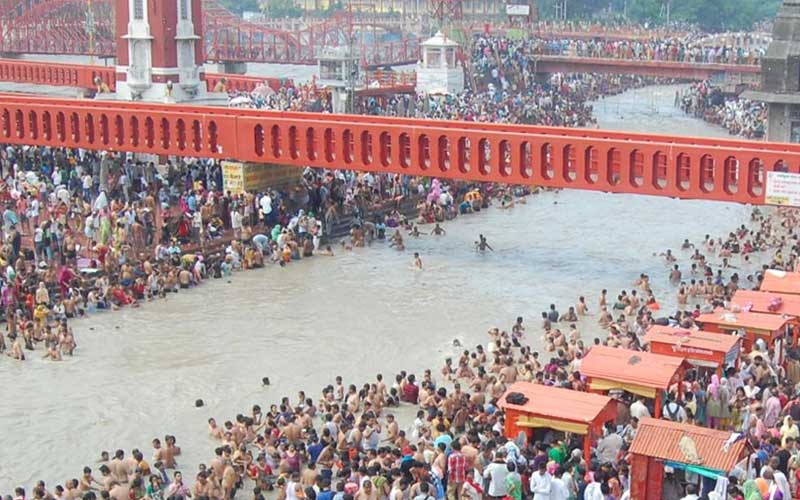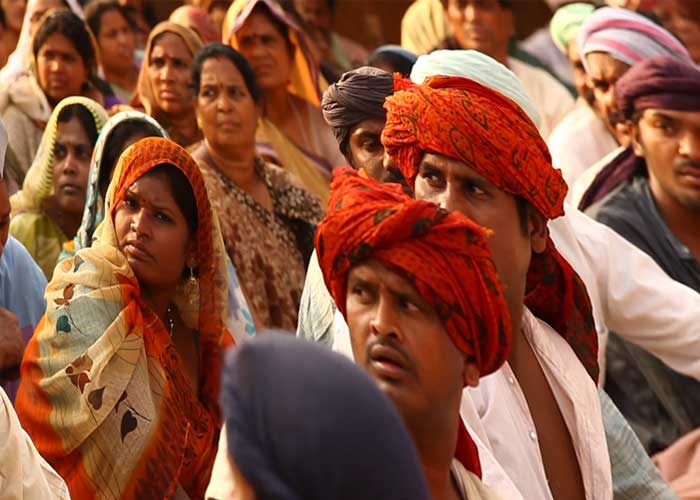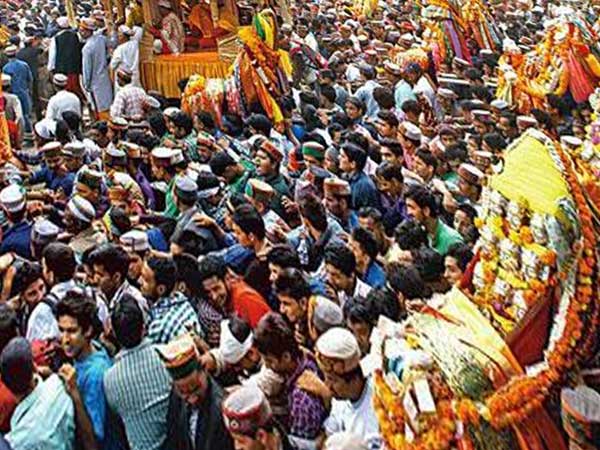Jammu and Kashmir Population 2024
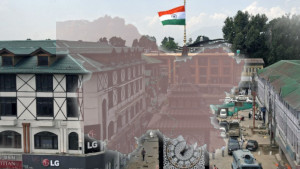


According to Modern History 1844 - 1994, Legend in the Rajatarangini and Nilmat Puran has it that the Valley of Kashmir was once a large lake. Rishi Kashyap drained off the water of the lake and made it a place of abode. The Geologists state that geological changes made way for the outflow of water by subsidence of the mount of Khadinayar, Baramula, Thus emerged the Valley of Kashmir.Jammu has also mentioned in Mahabharata and two recent finds of Harappan remains and artifacts of Mauryan, Kushan and Gupta periods of Akhnoor have added new dimensions to its ancient character.
Time lines of Jammu and Kashmir
- Kalhana begins the history of Kashmir with the reign of King Gonanda I (2448 BC) and records the reigns of over 100 kings during the period 2448 BC to 1101 AD.
- King Ashoka is said to have founded the old city of Srinagar also used to called as 'Shrinagari'. He built about 500 Buddhist monasteries to Buddhist Sangha. Several scholars from Tibet, China and Central Asia used to visit the valley.
- During the rule of Kanishka in First Century AD, a historical buddhist council was held at Shrinagari.
- In the early sixth century AD, control of the valley came into hands of the Huns. The Valley regained freedom in 530 AD, but soon came under the rule of the Ujjain empire.
- By 724AD to 761 AD, on the decline of Vikramaditya dynasty of Ujjain, the valley had its own rulers. There was a synthesis of Hindu and Buddhist Cultures. Lalitaditya was one of the most important Hindu rules of the Kashmir. He extended his rule unto Bengal in the east, Konkan in the south, Turkistan in the north-west and Tibet in the north-east. Lalitaditya constructed temples and he gave liberal grants to Buddhists.
- By 855 AD to 883, King Avantivarman ruled Kashmir, during this period Kashmir became prosperous with the number of improvement schemes of drainage, irrigation and agriculture, He founded city of Avantipur.
- During 1128 to 1155 Jaya Simha, The King himself set high standard of conduct and undertook various measures to improve the moral tone of the Kashmir society. He built famous Simhapura Maths.
- In 1320, the Hindu Kingdom of Kashmir received its first blow by the invasion of Dulacha, a Mongol warrior and adventurer who hailed from Turkistan.
- In 14th Century, Islam came to Kashmir, Zain-ul-Abedin was the most famous of the Muslim rulers who came to Kashmir and continued to rule till 1586 when Akbar conquered Kashmir. In 1589, Kashmir became a province of Mughal empire.
- During the reign of Aurangzeb 1658 - 1707, Kashmir saw as many of 14 Governors and huge migration of people, one of his Governors namely Iftikhar Khan(1671 -1675), persecuted Kashmiri Pandits who approached Sikh Guru, Ten Bahadur. Guru Teg Bahadur had to lay down his life to defend the people's right of choice of religion. On the spot, where he was beheaded under the orders of Mughal Emperor Aurangzeb, stands Gurudwara Sisganj in Delhi.
- Kashmir was under Sikh Rulers from 1819 AD to 1846, and Dogra Rulers from 1846 to 1947.
- The land is divided into 22 hill principalities. Raja Maldev, one of the Dogra rulers, expanded many territories. Raja Ranjit Dev ruled from 1733 to 1782. He later handed the region to Gulab Singh, an scion of the old Dogra ruling family. The period saw four rulers: Maharaja Gulab Singh (1846 - 1857), Ranbir Singh (1857 - 1885), Pratap Singh ( 1885 - 1925) and Hari Singh (1925 - 1952).
| Census year | Persons | Absolute | Percentage | Males | Females |
|---|---|---|---|---|---|
| 1901 | 2,139,362 | - | - | 1,136,766 | 1,002,596 |
| 1911 | 2,292,535 | 153,173 | 7.16 | 1,222,305 | 1,070,230 |
| 1921 | 2,424,359 | 131,824 | 5.75 | 1,296,205 | 1,128,154 |
| 1931 | 2,670,208 | 245,849 | 10.14 | 1,431,801 | 1,238,407 |
| 1941 | 2,946,728 | 276,520 | 10.36 | 1,577,021 | 1,369,707 |
| 1951 | 3,253,852 | 307,124 | 10.42 | 1,736,827 | 1,517,025 |
| 1961 | 3,560,976 | 307,124 | 9.44 | 1,896,633 | 1,664,343 |
| 1971 | 4,616,632 | 1,055,656 | 29.65 | 2,458,315 | 2,158,317 |
| 1981 | 5,987,389 | 1,370,757 | 29.69 | 3,164,660 | 2,822,729 |
| 1991 + | 7,837,051 | 1,849,662 | 30.89 | 4,142,082 | 3,694,969 |
| 2001 | 10,143,700 | 2,306,649 | 29.43 | 5,360,926 | 4,782,774 |
| 2011 | 12,541,302 | 2,397,602 | 23.64 | 6,640,662 | 5,900,640 |
Towns
The popular towns of Jammu and Kashmir are Gulmarg is a hill station town, a popular skiing destination in Baramula district. The Gulmarg population is 2200, Apharwat Peak, Gulmarg Gondola, Gulmarg Wildlife Sanctuary, Maharani Temple, Alpather Frozen Lake, St Mary Church and Baba Reshi Shrine are the popular place of Gulmarg.
Jammu is the the winter capital of state of Jammu and Kashmir in India. Jammu population is 550 thousand and is situated on the banks of the Tawi River. Bahu Fort, Amar Mahal Palace, Raghunath Temple, Mubarak Mandi Palace, Bagh-e-Bahu, Mahamaya Temple, Ranbireshwar Temple, Dogra Art Museum, Purmandal Temple are the popular places of Jammu.
Srinagar is the summer capital and largest city of Jammu and Kashmir. It lies on the banks of the Jhelum River, popular for traditional Kashmiri handicrafts and dried fruits. Popular places of Srinagar are Dal Lake, Chashme Shahi Gardens, Indira Gandhi Tulip Garden, Shalimar Bagh, Shalimar Bagh, Dachigam National Park, Nishat Bagh, Pari Mahal, Shankaracharya Temple, Nigeen Lake, Jamia Masjid, Hari Parbat and Sri Pratap Singh Museum.
Pahalgam is a town in Anantnag district, It is a popular tourist destination and hill station and is associated with the annual Amarnath Yatra, other places are Betaab Valley, Tulian Lake, Mamleshwar Temple and Aru Valley.
Awantipora is a town and a notified area committee in Pulwama district of the Indian state of Jammu & Kashmir. It is situated between Anantnag and Srinagar on National Highway.
Udhampur is a city and district, it is the fourth-largest city in the state,
Bandipora is the town and district, It has the second largest fresh water lake in Asia.
Population Pyramid
Jammu and Kashmir population pyramid is a graphical analysis of the age and sex of a population, pyramid with the wider base suggests growing population, with a narrow base indicates declining birth rates. Jammu and Kashmir population in 2022 is estimated to be 13.59 million, population in 2021 is estimated to be 13.65 million (1.36 Crores) and population in 2023 is estimated to be 13.62 Million.
Jammu and Kashmir Population by Religion
Religion is an important feature of a population as all religions have left an imprint on the culture, literature, art, food habits and politics. Jammu and Kashmir Religion wise, Followers of almost all the important religions Hinduism, Islam, Buddhism, Jainism and Christianity with their various denominations live there. According to the 2011 census, Jammu and Kashmir population religion wise, Muslim is followed by about 68.3%, 28.4% follow Hinduism, Sikhism (1.9%), Buddhism (0.9%) and Christianity (0.3%). The largest population religion wise is Muslim population accounts to 8.5 Million, followed by 3.5 Million by Hindus.
| Religion | Persons | Percentage | Males | Females |
|---|---|---|---|---|
| Hindu | 3,566,674 | 28.44 | 1,987,021 | 1,579,653 |
| Muslim | 8,567,485 | 68.31 | 4,428,774 | 4,138,711 |
| Christian | 35,631 | 0.28 | 21,523 | 14,108 |
| Sikh | 234,848 | 1.87 | 132,897 | 101,951 |
| Buddhist | 112,584 | 0.90 | 56,442 | 56,142 |
| Jain | 2,490 | 0.02 | 1,310 | 1,180 |
| Others | 1,508 | 0.01 | 802 | 706 |
| Not Stated | 20,082 | 0.16 | 11,893 | 8,189 |
Ethnic groups of Jammu and Kashmir



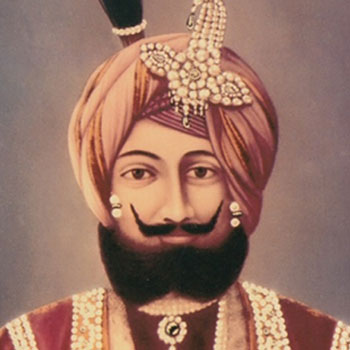
| Tribes | Population as per Census 2011 |
|---|---|
| All Scheduled Tribes | 1,493,299 |
| Bakarwal | 113,198 |
| Balti | 51,918 |
| Beda | 420 |
| Bot, Boto | 91,495 |
| Brokpa, Drokpa, Dard, Shin | 48,439 |
| Changpa | 2,661 |
| Gaddi | 46,489 |
| Garra | 504 |
| Gujjar | 980,654 |
| Mon | 829 |
| Purigpa | 39,101 |
| Sippi | 5,966 |
| Generic Tribes etc. | 111,625 |
Languages spoken in Jammu and Kashmir
The Languages are Urdu, Dogri, Kashmiri, Pahari, Ladakhi, Balti, Gojri and Dari.
| Languages | Persons | Percentage | Rural | Urban |
|---|---|---|---|---|
| Kashmiri | 6,680,837 | 53.2707 | 4,541,073 | 2,139,764 |
| Hindi | 2,612,631 | 20.8322 | 2,260,826 | 351,805 |
| Dogri | 2,513,712 | 20.0435 | 1,860,897 | 652,815 |
| Punjabi | 219,193 | 1.7478 | 92,595 | 126,598 |
| Bhotia | 107,451 | 0.8568 | 83,559 | 23,892 |
| Tibetan | 100,499 | 0.8013 | 84,334 | 16,165 |
| Khandeshi | 34,862 | 0.2780 | 32,948 | 1,914 |
| Shina | 32,027 | 0.2554 | 30,552 | 1,475 |
| Marathi | 23,006 | 0.1834 | 8,183 | 14,823 |
| Nepali | 22,138 | 0.1765 | 16,319 | 5,819 |
| Urdu | 19,956 | 0.1591 | 8,609 | 11,347 |
| Bengali | 19,830 | 0.1581 | 6,984 | 12,846 |
| Gujarati | 19,261 | 0.1536 | 9,426 | 9,835 |
| Tamil | 14,728 | 0.1174 | 4,532 | 10,196 |
| Telugu | 13,970 | 0.1114 | 4,197 | 9,773 |
| Balti | 12,399 | 0.0989 | 10,944 | 1,455 |
| Malayalam | 11,248 | 0.0897 | 3,732 | 7,516 |
| Odia | 9,553 | 0.0762 | 2,641 | 6,912 |
| Assamese | 8,340 | 0.0665 | 2,554 | 5,786 |
| Ladakhi | 7,638 | 0.0609 | 4,739 | 2,899 |
| Kannada | 6,953 | 0.0554 | 2,375 | 4,578 |
| Lahnda | 6,102 | 0.0487 | 2,112 | 3,990 |
| Manipuri | 2,370 | 0.0189 | 1,154 | 1,216 |
Disability
Census 2011 reveals that 121,532 people are suffering with various disability problems, Around 50% disbality are with seeing, speech and hearing problems.
| Type of disability | Total Persons | Cultivators | Agriculture labor | HHI | Other workers |
|---|---|---|---|---|---|
| Total disabled population | 121,532 | 37,696 | 19,171 | 5,597 | 59,068 |
| In Seeing | 22,281 | 7,732 | 3,728 | 962 | 9,859 |
| In Hearing | 29,855 | 7,648 | 3,926 | 1,101 | 17,180 |
| In Speech | 6,548 | 2,323 | 1,224 | 262 | 2,739 |
| In Movement | 19,323 | 6,441 | 3,212 | 920 | 8,750 |
| Mental Retardation | 3,980 | 1,382 | 723 | 170 | 1,705 |
| Mental Illness | 4,708 | 1,676 | 982 | 257 | 1,793 |
| Any Other | 25,856 | 7,104 | 3,645 | 1,483 | 13,624 |
| Multiple disability | 8,981 | 3,390 | 1,731 | 442 | 3,418 |
Jammu and Kashmir Population projection
As per the census registered in 1901 there were 2,139,362 people living in Jammu & Kashmir. Upto 1961 the growth rate was recorded between 5 .75 and 10.42 with of 3.5 million population by 1961. The growth rate was rapidly increased to 29.69% from 1961 to 1971 making about 300% rise and maintained around 30% from 1971 till 2001. From 2001 the population started declining with the growth rate of 23.64% reaching the population to 12.5 million till the last census in 2011. Jammu and Kashmir population in 2020 is estimated to be 13.6 million (1.36 Crores). By end of year 2019 the population is projected to be 13,468,313 as per Unique Identification Aadhar India, updated dec 2019. Region wise Kashmir has the highest population, followed by Jammu and Ladakh.
Rank of happiness
Jammu and Kashmir has the Human Develop Index of 0.684 which is greater than India's average of 0.640 and higher being Kerala with 0.784.
Income Distribution
Jammu and Kashmir's economy is dependent on agriculture, tourism and manufacturing activities, 45% of GDP from agriculture is contributed by horticulture sector. Horticulture is one of the key contributing industry sector and products like Apples, pears, almonds, walnuts, apricots and cherries are exported from Jammu and Kashmir to different parts of India by yielding turnover of approximately 850 million dollars(6000 crores) by 2015-16 with the production of 1636 thousand metric ton area of 357 thousand hectares. Wood from Kashmir is used to make cricket bats traded as "Kashmir willow bats".
Saffron cultivation is produced in this region which is exported to many countries, and over 16,000 families are engaged in saffron cultivation. Khrew region is the major share of Saffron production, In a decade from 2007 to 2019, around 2,400 hectares of saffron farms in Khrew shrank to 1,500 hectares, due to old agricultural practice, irrigation problems and mainly due to import of Iranian Saffron.
District wise population in Jammu and Kashmir
Jammu and Kashmir Territory is further divided into 20 districts. District wise population, Jammu is the highest populated district with close to 1.7 Million population (est 2019), followed by Srinagar with 1.2 Million, Anantnag and Baramulla with around 1 Million each. on 5th August Government of India introduced the bill to create Ladakh Region as Union Territory, Leh and Kargil are the two districts with an estimated population of 149,505 and 157,698 as on 2019.
| District | Population(2020 est.) | Population(2011) | Percentage |
|---|---|---|---|
| Kupwara | 992,204 | 870,354 | 6.94 |
| Badgam | 859,269 | 753,745 | 6.01 |
| Punch | 543,592 | 476,835 | 3.80 |
| Rajouri | 732,353 | 642,415 | 5.12 |
| Kathua | 702,736 | 616,435 | 4.92 |
| Baramula | 1,149,164 | 1,008,039 | 8.04 |
| Bandipore | 447,144 | 392,232 | 3.13 |
| Srinagar | 1,409,985 | 1,236,829 | 9.86 |
| Ganderbal | 339,088 | 297,446 | 2.37 |
| Pulwama | 638,902 | 560,440 | 4.47 |
| Shupiyan | 303,485 | 266,215 | 2.12 |
| Anantnag | 1,229,709 | 1,078,692 | 8.60 |
| Kulgam | 483,911 | 424,483 | 3.38 |
| Doda | 467,327 | 409,936 | 3.27 |
| Ramban | 323,433 | 283,713 | 2.26 |
| Kishtwar | 262,993 | 230,696 | 1.84 |
| Udhampur | 632,683 | 554,985 | 4.43 |
| Reasi | 358,720 | 314,667 | 2.51 |
| Jammu | 1,744,152 | 1,529,958 | 12.20 |
| Samba | 363,544 | 318,898 | 2.54 |
 India Population
India Population 